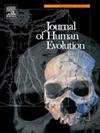Chimpanzee hind limb muscle electromyographic activity patterns during locomotion
IF 3.1
1区 地球科学
Q1 ANTHROPOLOGY
引用次数: 0
Abstract
Functional interpretation of fossils documenting our early locomotor evolution relies on biomechanical analyses of modern humans and comparative samples of nonhuman primates. Force plate studies have explored the forces that nonhuman primate limbs exchange with the ground while walking bipedally or quadrupedally, and kinematic studies have detailed limb and joint motion profiles during various forms of locomotion. Much less is known about patterns of hind limb muscle use as revealed through electromyography despite the fact that the interpretation of many features of fossils has been related to aspects of muscle use. To better understand how muscle function may relate to the interpretation of fossil material, the current study focuses on chimpanzees and presents electromyography-based activity profiles for the majority of their hind limb muscles during knuckle-walking, bipedalism, and vertical climbing. Taking advantage of the long history of the Stony Brook Primate Locomotion Lab, this study has compiled electromyographic data from eight chimpanzee subjects to both document hind limb muscle activity patterns and explore variability in those recruitment profiles. The collected data indicate that while there are many commonalities in patterns of muscle use, there is also a fair amount of intersubject variation. Overall, the locomotor adaptive strategy of chimpanzees appears to emphasize versatility and maneuverability rather than energy-efficient locomotion. It is hoped that these data will broaden perspectives on how patterns of muscle use may influence the interpretation of fossils.
黑猩猩后肢肌肉运动时的肌电图活动模式。
记录我们早期运动进化的化石的功能解释依赖于现代人类的生物力学分析和非人灵长类动物的比较样本。力板研究探索了非人类灵长类动物在两足或四足行走时肢体与地面交换的力,运动学研究详细描述了各种运动形式下肢体和关节的运动特征。尽管对化石的许多特征的解释与肌肉使用的各个方面有关,但通过肌电图揭示的后肢肌肉使用模式知之甚少。为了更好地理解肌肉功能如何与化石材料的解释相关,目前的研究集中在黑猩猩身上,并展示了它们在指关节行走、两足行走和垂直攀爬过程中大部分后肢肌肉的肌电图活动特征。利用石溪灵长类动物运动实验室的悠久历史,本研究收集了8只黑猩猩的肌电图数据,以记录后肢肌肉活动模式,并探索这些招募档案的可变性。收集的数据表明,虽然肌肉使用模式有许多共性,但也存在相当数量的主体间差异。总的来说,黑猩猩的运动适应策略似乎强调多功能性和机动性,而不是节能运动。希望这些数据能拓宽肌肉使用模式如何影响化石解释的视角。
本文章由计算机程序翻译,如有差异,请以英文原文为准。
求助全文
约1分钟内获得全文
求助全文
来源期刊

Journal of Human Evolution
生物-进化生物学
CiteScore
6.30
自引率
15.60%
发文量
104
审稿时长
3 months
期刊介绍:
The Journal of Human Evolution concentrates on publishing the highest quality papers covering all aspects of human evolution. The central focus is aimed jointly at paleoanthropological work, covering human and primate fossils, and at comparative studies of living species, including both morphological and molecular evidence. These include descriptions of new discoveries, interpretative analyses of new and previously described material, and assessments of the phylogeny and paleobiology of primate species. Submissions should address issues and questions of broad interest in paleoanthropology.
 求助内容:
求助内容: 应助结果提醒方式:
应助结果提醒方式:


